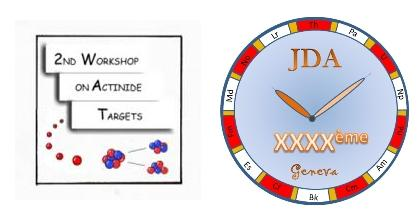Speaker
Dr
António Pereira Gonçalves
(Instituto Tecnológico e Nuclear)
Description
Magnetic ordering in the heavy-fermion compound UZn12
A.P. Gonçalves1,*, D. Gnida2, P. Estrela3,4, A. de Visser4, E.B. Lopes1, I. Catarino5, G. Bonfait5, M. Godinho6, M. Almeida1, D. Kaczorowski2
1 Dep. Química, Instituto Tecnológico e Nuclear, P-2686-953 Sacavém, Portugal.
2 Institute of Low Temperature and Structure Research, Polish Academy of Sciences, P.O.Box 1410, 50-950 Wroclaw, Poland
3 Dep. Electronic & Electrical Engineering, University of Bath, Bath, BA2 7AY, UK
4 Van der Waals-Zeeman Institute, Univ. Amsterdam, Valckenierstraat 65, 1018 XE Amsterdam, The Netherlands.
5 Dep. Física, FCT-UNL, 2829-516 Monte da Caparica, Portugal.
6 Dep. Física, FC-UL, Campo Grande ed. C1, P-1749-016 Lisboa, Portugal.
U-based intermetallic compounds continue attracting much attention due to a wide spectrum of their unusual physical properties. Some of them belong to the class of the so-called heavy-fermion systems, and a few of these systems order magnetically at low temperatures, usually with antiferromagnetic structures.
The binary U-Zn phase diagram contains two intermetallic compounds, U2Zn17 and UZn12. The low temperature polymorph of U2Zn17 (Th2Zn17-type) has been deeply studied. The compound shows antiferromagnetic ordering below TN = 9.8 K, with a sizeable magnetic anisotropy both in the antiferromagnetic and paramagnetic regions [1]. Its Sommerfeld coefficient is equal to 535 mJ/(mol K2) [2], indicating a heavy-fermion character of the electronic ground state. The other phase, UZn12, crystallizes in the hexagonal high-temperature form of SmZn12 (P6/mmm) [3]. Single-crystal X-ray data revealed some disorder in the crystal lattice, which leads to compositions deficient in zinc, ranging from UZn9.4 to UZn11.5 [4]. Specific heat measurements, performed on polycrystalline samples, revealed a heavy-fermion behaviour of this compound, with (0) = 850-900 mJ/(mol K2) [5,6]. Neither magnetic nor superconducting phase transitions were observed down to 0.4 K [5,6].
The present work reports on the growth of UZn12 single crystals, and their study by means of X-ray diffraction, magnetisation, specific heat, and electrical resistivity measurements. These experiments have been supplemented by muon spin relaxation spectroscopy, carried out on polycrystalline sample from the same batch.
Single crystals of UZn12 with typical dimensions 1.5x1.5x0.2 mm3 were grown by the high-temperature solution growth method, using zinc as solvent. Single crystal X-ray diffraction studies confirmed the SmZn12-type structure with the refined composition U1.01(1)Zn11.7(1) that is much closer to the ideal one than those reported in the literature [4]. The U atoms are mainly located at the 1a and 2d sites, with the U-U shortest distances (2d-2d) of ~5.164 Å. However, ~4% of the U atoms were also found at the 2c site due to a partial substitution of the 4h Zn pairs.
At odds with the literature data [5,6], bulk magnetization measurements of single-crystalline UZn12 revealed an antiferromagnetic-type anomaly at 5.0(2) K. This singularity was observed for both characteristic directions in the hexagonal unit cell, but its magnitude was much less pronounced for B || c-axis, hence suggesting that the magnetic moments are confined within the a-b plane. The presence of long-range magnetic order below 5 K was confirmed by muon spin relaxation experiments.
The specific heat of UZn12 measured in zero magnetic field exhibits a clear -type anomaly near TN = 5 K. Upon applying magnetic fields, directed with the a-b plane, the peak in C(T) shifts to lower temperatures, as expected for aniferrromagnets. From the analysis of the specific heat data between 8 and 13 K, the electronic specific heat coefficient p ≈ 340 mJ/(mol K2) is obtained. From the data measured below 3.7 K, the (0) value as large as 800 mJ/(mol K2) can be derived. The strongly enhanced electronic contribution to the specific heat corroborates the previously formulated hypothesis [5,6] that UZn12 can be classified as a heavy-fermion system.
The heavy-fermion character of UZn12 manifests clearly in the overall shape of temperature-dependent electrical resistivity that is dominated by a single-ion Kondo effect at high temperatures and coherent Kondo scattering at low temperatures. From room temperature down to about 150 K, the resistivity changes with temperature in a logarithmic manner. At about 15 K, a maximum in (T) is seen, which marks a crossover from incoherent to coherent Kondo regime. Below this temperature the resistivity decreases with decreasing temperature down to about 80 cm at 2 K. This rather large value indicates significant residual scattering, mainly caused by the inherent atomic disorder, evidenced in the X-ray studies, but probably also due to significant disorder in the spin system that persists down to the lowest temperatures. Remarkably hardly any singularity in (T) occurs at the antiferromagnetic phase transition at TN = 5 K. It seems likely that the expected change at TN in the magnetic contribution to the resistivity is obscured by the much more effective scattering conduction electrons on structural and magnetic defects.
In conclusion, UZn12 is a heavy-fermion system with antiferromagnetic ordering below 5 K. The obtained results point to a fundamental role of structural disorder on the onset of magnetism in this compound.
Acknowledgments
This work was partially supported by the Executive Programme of Scientific and Technological Cooperation between Portugal and Poland, for the years 2009-2010, and by FCT, Portugal, under the contract nr. PTDC/QUI/65369/2006.
References
1- J.O. Willis, Z. Fisk, R.M. Aikin, M.W. McElfresh, J.D. Thompson, E. Zirngiebl, J.A. O'Rourke, J.L. Smith, J. Appl. Phys., 61 (1987) 4373.
2- H.R. Ott, H. Rudigier, P. Delsing, Z. Fisk, Phys. Rev. Lett., 52 (1984) 1551.
3- J.T. Mason, P. Chiotti, Acta Cryst. B27 (1971) 1789.
4- P. Chiotti, J.T. Mason, J. Less-Common Metals 40 (1975) 39
5- Y. Nakazawa, M. Ishikawa, S. Noguchi and K. Okuda, Physica B 186-188 (1993) 711.
6- Y. Nakazawa, M. Ishikawa, S. Noguchi and K. Okuda, J. Phys. Soc. Jpn. 62 (1993) 3003.
Primary author
Dr
António Pereira Gonçalves
(Instituto Tecnológico e Nuclear)




